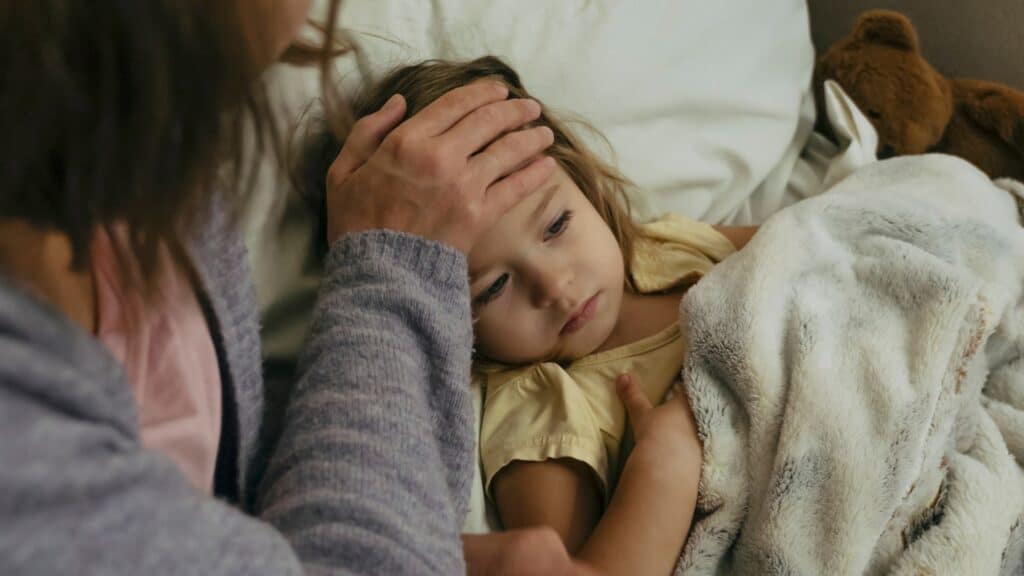There are certain rites of passage every parent experiences: the first gummy smile, those wobbly first steps, and yes, the first fever that sends you reaching for the thermometer and debating whether it’s time to call the pediatrician.
Even in the healthiest and most seasoned of families, it’s normal for parents to carry with them common pediatric questions, from wondering how much Motrin to give to whether your child is hitting their milestones appropriately. For families looking for extra pediatric support, My Pediatrician Friend recently launched by three pediatrician moms looking to fill a gap in the system. They’re a text message-based service designed to make life easier for parents in the realm of children’s health. Their goal isn’t to replace any current forms of care (pediatrician, ER, urgent care) but to be that extra layer of support. Messages parents send go directly to their three board certified pediatrician moms through a HIPAA compliant texting app.
We recently asked the pediatrician moms behind My Pediatrician Friend the five most common pediatric questions they receive—plus the no-nonsense advice they wish every family knew.
How Long Should My Child Have a Fever Before Going to the Doctor?
Fevers are a normal part of childhood. Every baby and child will get them, and we totally understand the fear that comes with seeing that number on the thermometer climb.
But, fevers are just a sign that your child’s body is doing exactly what it’s supposed to do: fighting back.
Let’s walk through what’s normal, what’s not, and what you should actually do next.
First of all, if your baby is under two months old, this is the one age group where a fever is always an emergency.
- You can call your pediatrician, but they’ll tell you the same thing: head to the ER for further evaluation.
- A rectal temperature of 100.4°F (38°C) or higher in a baby under 2 months means a trip to the emergency room—no exceptions.
Fever Basics & When to Check In
Most fevers in kids are caused by viruses and will resolve on their own in 3–5 days with rest, hydration, and supportive care. But here are a few signs that it’s time to check in with your pediatrician:
Fever that Goes Away and Then Comes Back
- This can be a sign of a bacterial infection on top of a virus like an ear infection or pneumonia.
- Call your pediatrician for an in-person exam.
Fever That Lasts More Than 5 Days
- If your child still has a fever after 5 days (and you haven’t already seen your doctor), it’s time for a visit to rule out a secondary infection or other cause.
Other Symptoms to Watch For:
- Ear pulling or complaints of ear pain
- Frequent urination or pain with urination
- Flu-like symptoms during flu season
These could indicate something that does require medication or further workup. In these cases, it’s better to catch it early!
How Can I Help My Child with a Viral Infection?
Supportive care involves helping your child manage the symptoms of a viral infection by keeping them comfortable and allowing their body to heal on its own.
If your pediatrician has said, “It’s probably a virus,” here’s what you can do:
- Focus on hydration. Kids often eat less when sick, and that’s okay. The goal is fluids, fluids, fluids.Think water, Pedialyte, popsicles, Gatorade, broth, Pedialyte pops—whatever gets the job done.
- Watch their pee. If your child is having fewer wet diapers or going significantly less often, let your care team know.
- Treat fevers for comfort. Use Tylenol (acetaminophen) or Motrin (ibuprofen) based on your child’s weight. Then re-check how they’re doing after the fever comes down. Remember that ibuprofen is not for children less than 6 months old.
Red Flags: When to Seek Immediate Medical Attention
- Signs of respiratory distress:
- Rapid breathing
- Nostrils flaring
- Skin pulling in between the ribs or under the ribs (called retractions)
- Trouble catching their breath or speaking
- Rapid breathing
If you’re seeing any of these signs—or you’re just not sure—call your pediatrician or head to urgent care or the ER.
Pro Tips
- Kids often look much worse when they have a fever. Treat the fever, then reassess.
- Antibiotics don’t work on viruses, so most care is supportive (hydration, rest, fever relief).
When Is a Fever Too High for a Child?
First things first. Fevers are not dangerous in and of themselves. They won’t damage your child’s brain or cause long-term harm. A fever simply means the body is doing what it’s supposed to do: fighting off an infection.
So why do we treat fevers with medication? Not because they’re dangerous, but because they’re uncomfortable. Your child may be achy, tired, or just plain miserable, and that’s where fever reducers come in: to help them feel better.
Also some kids just run hot. Different viruses cause different fever patterns. And some kids are just what we lovingly call “fever kids.”
Quick Guidance
- Medications that reduce fever are called antipyretics. The most common ones are Tylenol (acetaminophen) and Motrin/Advil (ibuprofen).
- These medications work differently in the body but can both be safely used and even alternated, when needed. The key is dosing by weight, not age. We have a super handy fever dosing chart in our membership portal to make those middle-of-the-night decisions easier.
Pro Tips
- If your child hates taking medications try mixing them into something yummy: yogurt, pudding, applesauce, ice cream.
- Use the form that works best for your child: whether its liquid, chewable, or even rectal suppositories for kids who won’t take anything by mouth
- If you are not seeing the fever go down, make sure you double check the dose. It may need to be adjusted for their weight.
Bottom line:
Fevers are part of the process—and most of the time, they’re not something to fear. Focus on keeping your child comfortable, hydrated, and loved. And when in doubt, My Pediatrician Friend or your provider is just a message away.
Can You Give Tylenol and Motrin Together?
We get this question all the time. What’s the right dose of Tylenol or Motrin for my child? Here’s the key thing to know: medication dosing for children is based on weight, not age, so it changes as your child grows.
Infants Under 2 Months:
If your baby is under 2 months old and has a fever, do not give any medication. A fever in this age group is considered a medical emergency and should be evaluated right away.
Babies Under 6 Months:
- Tylenol (acetaminophen) is safe to use.
- Motrin (ibuprofen) should not be given until your child is at least 6 months old.
What’s the Difference Between Tylenol and Motrin?
Tylenol is processed by the liver. It can be given every 4–6 hours. Motrin is processed by the kidneys. It can be given every 6 hours, and we often prefer it for fevers, pain, and inflammation. It tends to work a bit better and last longer so it’s our medication of choice when trying to bring down a fever.
Pro Tips:
- Always check the concentration on the medication bottle. Infant Motrin is more concentrated than children’s Motrin, so the dosing is different.
- Alternating Tylenol and Motrin can be done when needed (like for persistent high fevers), but first talk to your pediatrician about the safest way to do it.
Still unsure about the dose? A quick call to your pediatrician—or checking a reliable weight-based dosing chart—can give you peace of mind.
Why Is My Child Sick So Often? Is This Normal?
Unfortunately, every kid is going to get sick! It’s part of the deal, especially during the toddler years when they’re tasting the world (literally), building their immune systems, and being exposed to new germs for the very first time.
So if your child is catching one thing after another, that’s normal. And it’s okay.
The goal is not to keep them in a bubble. We don’t want to avoid every single bug or stress over every sniffle. What we do want is to:
- Let kids explore, interact, and play
- Normalize getting sick without fear or guilt
- Foster a healthy relationship with illness and not anxiety around germs
Here’s the reality: healthy babies and toddlers in daycare or preschool can get sick 10–12 times a year. That’s roughly once a month, sometimes more during cold and flu season. And sometimes those illnesses can come back to back so it will feel like they are sick almost every other week.
It’s frustrating, but it’s also how immune systems learn to fight. You’re not doing anything wrong. You’re just raising a kid who’s building lifelong defenses.
Pro Tip: Healthy Habits on the Go
Germs are everywhere—but good habits go a long way.
- Keep hand sanitizer handy for those moments when your child has just lovingly touched every subway railing in sight.
- Wash hands before eating, especially after being out in public.
- And don’t forget that staying up to date on vaccinations is one of the most powerful ways to protect your child from serious illnesses.
It’s not about avoiding every single germ. It’s about building smart habits that help keep kids healthy (and you a little more sane).
Pediatrician Advice from the Pros (That’s Us!)
Kids have a way of keeping us on our toes. They don’t follow any textbook, whether it’s getting sick, hitting developmental milestones, or just figuring out what a “normal” diaper looks like. With so much conflicting information online, it’s easy to spiral into worst-case scenarios and fall into the trap of endless doom-scrolling.
The truth is, kids are messy, unpredictable, and wonderfully unique, and that includes their health and development. Navigating the ups and downs is part of the parenting journey, but you don’t have to do it alone. Reaching out for support and guidance from trusted sources like your pediatrician and My Pediatrician Friend (MPF) is one of the strongest tools you can have in your parenting toolkit. Remember, we’ve answered thousands of questions and we all agree that no question is too small. You are already doing amazing and we are here to make it just a little bit easier!



